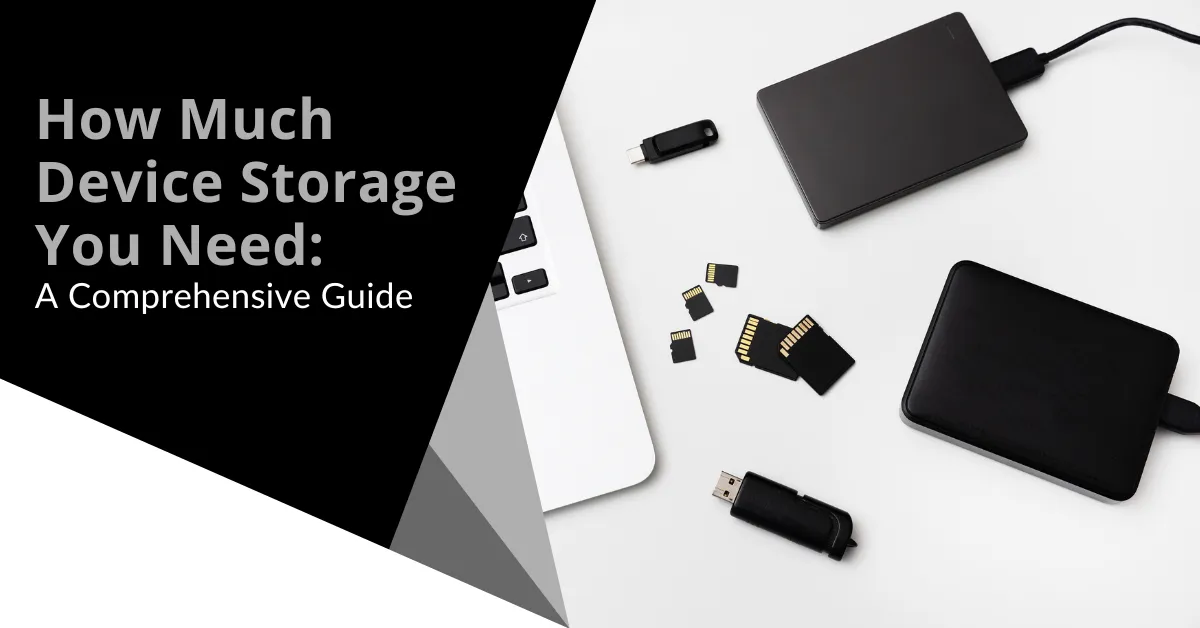
How Much Device Storage You Need: A Comprehensive Guide
Device storage determines how many apps, photos, videos, and files your device can hold. When space runs out, performance and productivity often take a hit. However, choosing the right amount of storage isn’t always straightforward. It’s easy to underestimate your needs—or spend more than necessary on unused space. This guide will help you figure out how much storage is just right for your needs.
What is device storage?
Device storage is the space available on your phone, tablet, or computer to hold data—such as apps, photos, videos, and documents. When storage is full, you won’t be able to save new files unless you delete old ones, pay for cloud storage, or upgrade your device.
There are two main types of storage:
Internal Storage: Built directly into the device, it’s usually faster and cannot be removed.
External Storage: Includes SD cards and USB drives that can be added or removed. These offer extra space, though they may operate more slowly.
Storage capacities vary widely by device:
Smartphones: Typically start at 64GB, with premium models offering up to 1TB. iPhones don’t support SD cards, but many Android phones do.
Tablets: Usually offer 32GB to 256GB, with some models supporting expandable memory.
Laptops: Range from 128GB to 1TB and can often be upgraded.
Desktops: Commonly start at 1TB and can go up to 4TB or more, with easy expansion options.
How Much Storage Do You Really Need?
Your storage needs depend on how you use your device. It’s easy to go too big or too small, so here’s a breakdown by user type:
Basic Users
If you mostly browse the internet, check emails, and use a few social apps, 64GB may be enough. This typically covers:
Email and messaging
Social media apps
Occasional photo or video use
Average Users
If you use your device for photos, multiple apps, and some videos, 128GB to 256GB is a safer choice. This suits:
Moderate app usage
Photo and video libraries
Occasional downloads and media storage
Power Users
If you’re into heavy apps or content creation, you’ll want 512GB or more. This supports:
Video editing and content creation
Large game libraries
Extensive media collections
Professional Users
For those working with large files or professional-grade software, 1TB or more is ideal. This includes:
4K or 8K video production
Massive datasets
Professional photo editing workflows
How Can You Manage Device Storage Better?
Even with a lot of space, poor storage habits can lead to issues. Here are some effective ways to optimize your storage:
Use cloud storage: Services like Google Drive or iCloud let you store files online and free up device space. In fact, over 65% of users rely on cloud storage as their primary method.
Delete unused apps: Removing apps you no longer use frees up significant space and can improve performance.
Clear cache regularly: Many apps store temporary files that build up over time. Clearing these helps reclaim space.
Stream instead of download: Stream music, movies, and shows when possible instead of downloading them to your device.
What Takes Up the Most Storage?
Not all files are created equal. Here’s what typically consumes the most space:
Videos: These are the biggest culprits—just one hour of 4K video can use over 7GB.
Photos: While smaller than videos, photo collections grow quickly. 1,000 high-quality images can take up around 5GB.
Games: Modern games are massive, with some titles exceeding 100GB.
Apps: While many are small, professional or creative apps (like editing software) can be quite large.
What to Do If You Run Out of Storage?
If you’re low on space, you have a few options:
Add storage: Use SD cards, USB drives, or external hard drives if your device supports them.
Upgrade your device: Choosing a model with more built-in storage may be a better long-term solution.
Move files to the cloud: Services like Dropbox, Google Drive, and OneDrive can offload photos, videos, and documents to the cloud.
How to Choose the Right Storage for Your Next Device
When shopping for a new device, think about how you use it daily. Do you take a lot of photos? Download lots of apps? Work with large files? Consider these factors when choosing your storage capacity.
When in doubt, opt for more storage than you think you’ll need—it’s better to have extra room than to run out too soon.
Now that you’re better informed about device storage, you’ll be able to make smarter choices for your next device. And remember—your storage needs may grow over time, so plan with the future in mind.
Still unsure about what you need? Contact us for personalized advice—we're here to help you find the perfect fit.

